Highly Robust Observer Sliding Mode Based Frequency Control for Multi Area Power Systems with Renewable Power Plants
Abstract
:1. Introduction
- ❖
- ❖
- The new SPSS and controller are designed to depend only on the observer which is useful for real power application where the system states variables are difficult or expensive to measure.
- ❖
- The whole system stabilization is theoretically proven using Lyapunov stability theory based new linear matrix inequality (LMI) technique.
- ❖
- Experimental simulation results depict the better performance in terms settling time and overshoot in comparison with recently results.
2. State Space Power System Model
3. Observer Design
4. SMC via Single Phase Surface Design
4.1. New Single Phase Sliding Surface
4.2. Theoretical Prove of System Dynamic Stabilization
5. Simulation Results and Discussions
5.1. Simulation 1
5.1.1. Case 1
5.1.2. Case 2
5.2. Simulation 2
6. Conclusions
Author Contributions
Funding
Data Availability Statement
Conflicts of Interest
References
- Pandey, S.K.; Mohanty, S.R.; Kishor, N. A literature survey on load–frequency control for conventional and distribution generation power systems. Renew. Sustain. Energy Rev. 2013, 25, 318–334. [Google Scholar] [CrossRef]
- Thirunavukarasu, R.; Chidambaram, I. PI2 controller based coordinated control with Redox flow battery and unified power flow controller for improved restoration indices in a deregulated power system. Ain Shams Eng. J. 2016, 7, 1011–1027. [Google Scholar] [CrossRef]
- Farahani, M.; Ganjefar, S.; Alizadeh, M. PID controller adjustment using chaotic optimization algorithm for multi-area load frequency control. IET Control. Theory Appl. 2012, 6, 1984–1992. [Google Scholar] [CrossRef]
- Saxena, S.; Hote, Y.V. Decentralized PID load frequency control for perturbed multi-area power systems. Int. J. Electr. Power Energy Syst. 2016, 81, 405–415. [Google Scholar] [CrossRef]
- Yousef, H. Adaptive fuzzy logic load frequency control of multi-area power system. Int. J. Electr. Power Energy Syst. 2015, 68, 384–395. [Google Scholar] [CrossRef]
- Chaturvedil, D.K.; Satsangi, P.S.; Kalra, P.K. Load frequency control: A generalized neural network approach. Electr. Power Energy Syst. 1999, 21, 405–415. [Google Scholar] [CrossRef]
- Indulkar, C.S.; Raj, B. Application of fuzzy controller to automatic generation control. Electr. Mach. Power Syst. 1995, 23, 209–220. [Google Scholar] [CrossRef]
- Ghoshal, S.P. Multi area frequency and tie line power flow control with fuzzy logic based integral gain scheduling. J. Inst. Eng. 2003, 84, 135–141. [Google Scholar]
- Sinha, S.K.; Patel, R.N.; Prasad, R. Application of GA and PSO tuned fuzzy controller for AGC of three area thermal-thermal-hydro power system. Int. J. Comput. Theory Eng. 2010, 2, 238–244. [Google Scholar] [CrossRef]
- Juang, C.-F.; Lu, C.-F. Load-frequency control by hybrid evolutionary fuzzy PI controller. IEE Proc. Gener. Transm. Distrib. 2006, 153, 196–204. [Google Scholar] [CrossRef]
- Arya, Y.; Kumar, N. BFOA-scaled fractional order fuzzy PID controller applied to AGC of multi-area multi-source electric power generating sys-tems. Swarm Evol. Comput. 2017, 32, 202–218. [Google Scholar] [CrossRef]
- Fathy, A.; Kassem, A.M.; Abdelaziz, A.Y. Optimal design of fuzzy PID controller for deregulated LFC of multi-area power system via mine blast algorithm. Neural Comput. Appl. 2018, 32, 4531–4551. [Google Scholar] [CrossRef]
- Haroun, A.G.; Li, Y. A novel optimized hybrid fuzzy logic intelligent PID controller for an interconnected multi-area power system with physical constraints and boiler dynamics. ISA Trans. 2017, 71, 364–379. [Google Scholar] [CrossRef] [PubMed]
- Kouba, N.E.Y.; Menaa, M.; Hasni, M.; Boudour, M. Load frequency control in multi-area power system based on Fuzzy Logic-PID Controller. In Proceedings of the 2015 IEEE International Conference on Smart Energy Grid Engineering (SEGE), Oshawa, ON, Canada, 17–19 August 2015; pp. 1–6. [Google Scholar]
- Sahu, R.K.; Panda, S.; Yegireddy, N.K. A novel hybrid DEPS optimized fuzzy PI/PID controller for load frequency control of multi-area intercon-nected power systems. J. Process. Control. 2014, 24, 1596–1608. [Google Scholar] [CrossRef]
- Jagatheesan, K.; Anand, B.; Samanta, S.; Dey, N.; Ashour, A.S.; Balas, V.E. Design of a proportional-integral-derivative controller for an automatic generation control of multi-area power thermal systems using firefly algorithm. IEEE/CAA J. Autom. Sin. 2017, 6, 503–5151. [Google Scholar] [CrossRef]
- Mohapatra, T.K.; Sahu, B.K. Design and implementation of SSA based fractional order PID controller for automatic generation control of a multi-area, multi-source interconnected power system. In Proceedings of the Technologies for Smart-City Energy Security and Power (ICSESP), Bhubaneswar, India, 28–30 March 2018; pp. 1–6. [Google Scholar]
- Raju, M.; Saikia, L.C.; Sinha, N. Automatic generation control of a multi-area system using ant lion optimizer algorithm based PID plus second order derivative controller. Int. J. Electr. Power Energy Syst. 2016, 80, 52–63. [Google Scholar] [CrossRef]
- Jianping, G. Sliding Mode Based Load Frequency Control for an Interconnected Power System with Nonlinearities. Ph.D. Thesis, Cleveland State University, Cleveland, OH, USA, 2015. [Google Scholar]
- Vrdoljak, K.; Perić, N.; Petrović, I. Sliding mode based load-frequency control in power systems. Electr. Power Syst. Res. 2010, 80, 514–527. [Google Scholar] [CrossRef]
- Prasad, S.; Purwar, S.; Kishor, N. Non-linear sliding mode control for frequency regulation with variable-speed wind turbine systems. Int. J. Electr. Power Energy Syst. 2019, 107, 19–33. [Google Scholar] [CrossRef]
- Trip, S.; Cucuzzella, M.; De Persis, C.; van der Schaft, A.; Ferrara, A. Passivity-based design of sliding modes for optimal load frequency control. IEEE Trans. Control. Syst. Technol. 2018, 27, 1893–1906. [Google Scholar] [CrossRef] [Green Version]
- Huynh, V.V.; Tsai, Y.-W.; Duc, P.V. Adaptive output feedback sliding mode control for complex interconnected time-delay systems. Math. Probl. Eng. 2015, 1–15. [Google Scholar] [CrossRef] [Green Version]
- Lee, S.-W.; Chun, K.-H. Adaptive sliding mode control for PMSG wind turbine systems. Energies 2019, 12, 595. [Google Scholar] [CrossRef] [Green Version]
- Lv, X.; Sun, Y.; Wang, Y.; Dinavahi, V. Adaptive event-triggered load frequency control of multi-area power systems under networked environ-ment via sliding mode control. IEEE Access 2020, 8, 86585–86594. [Google Scholar] [CrossRef]
- Le Ngoc Minh, B.; Van Huynh, V.; Nguyen, T.M.; Tsai, Y.W. Decentralized adaptive double integral sliding mode controller for multi-area power systems. Math. Probl. Eng. 2018, 2018, 1–11. [Google Scholar] [CrossRef]
- Guo, J. Application of full order sliding mode control based on different areas power system with load frequency control. ISA Trans. 2019, 92, 23–34. [Google Scholar] [CrossRef] [PubMed]
- Sarkar, M.K.; Dev, A.; Asthana, P.; Narzary, D. Chattering free robust adaptive integral higher order sliding mode control for load frequency problems in multi-area power systems. IET Control. Theory Appl. 2018, 12, 1216–1227. [Google Scholar] [CrossRef]
- Dev, A.; Sarkar, M.K.; Asthana, P.; Narzary, D. Event-triggered adaptive integral higher-order sliding mode control for load frequency problems in multi-area power systems. Iran. J. Sci. Technol. Trans. Electr. Eng. 2019, 43, 137–152. [Google Scholar] [CrossRef]
- Hu, R.; Deng, H.; Zhang, Y. Novel dynamic-sliding-mode-manifold-based continuous fractional-order nonsingular terminal sliding mode control for a class of second-order nonlinear systems. IEEE Access 2020, 8, 19820–19829. [Google Scholar] [CrossRef]
- Dev, A.; Sarkar, M.K. Robust higher order observer based non-linear super twisting load frequency control for multi area power systems via sliding mode. Int. J. Control. Autom. Syst. 2019, 17, 1814–1825. [Google Scholar] [CrossRef]
- Prasad, S.; Purwar, S.; Kishor, N. Load frequency regulation using observer based non-linear sliding mode control. Int. J. Electr. Power Energy Syst. 2019, 104, 178–193. [Google Scholar] [CrossRef]
- Tsai, Y.W.; Van, H.V. Adaptive Output Feedback Control for Mismatched Uncertain Systems: Single Phase Sliding Mode Approach. In Proceedings of the International Symposium on Computer, Consumer and Control, Taichung, Taiwan, 10–12 June 2014; pp. 990–993. [Google Scholar]
- Boyd, S.; El Ghaoui, L.; Feron, E.; Balakrishnan, V. Linear Matrix Inequalities in System and Control Theory; Society for Industrial and Applied Mathematics (SIAM): Philadelphia, PA, USA, 1994. [Google Scholar]
- Manikandan, S.; Kokil, P. Stability analysis of load frequency control system with constant communication delays. IFAC Papersonline 2020, 53, 338–343. [Google Scholar] [CrossRef]
- Liao, K.; Xu, Y. A robust load frequency control scheme for power systems based on second-order sliding mode and extended disturbance observer. IEEE Trans. Ind. Inform. 2017, 14, 3076–3086. [Google Scholar] [CrossRef]
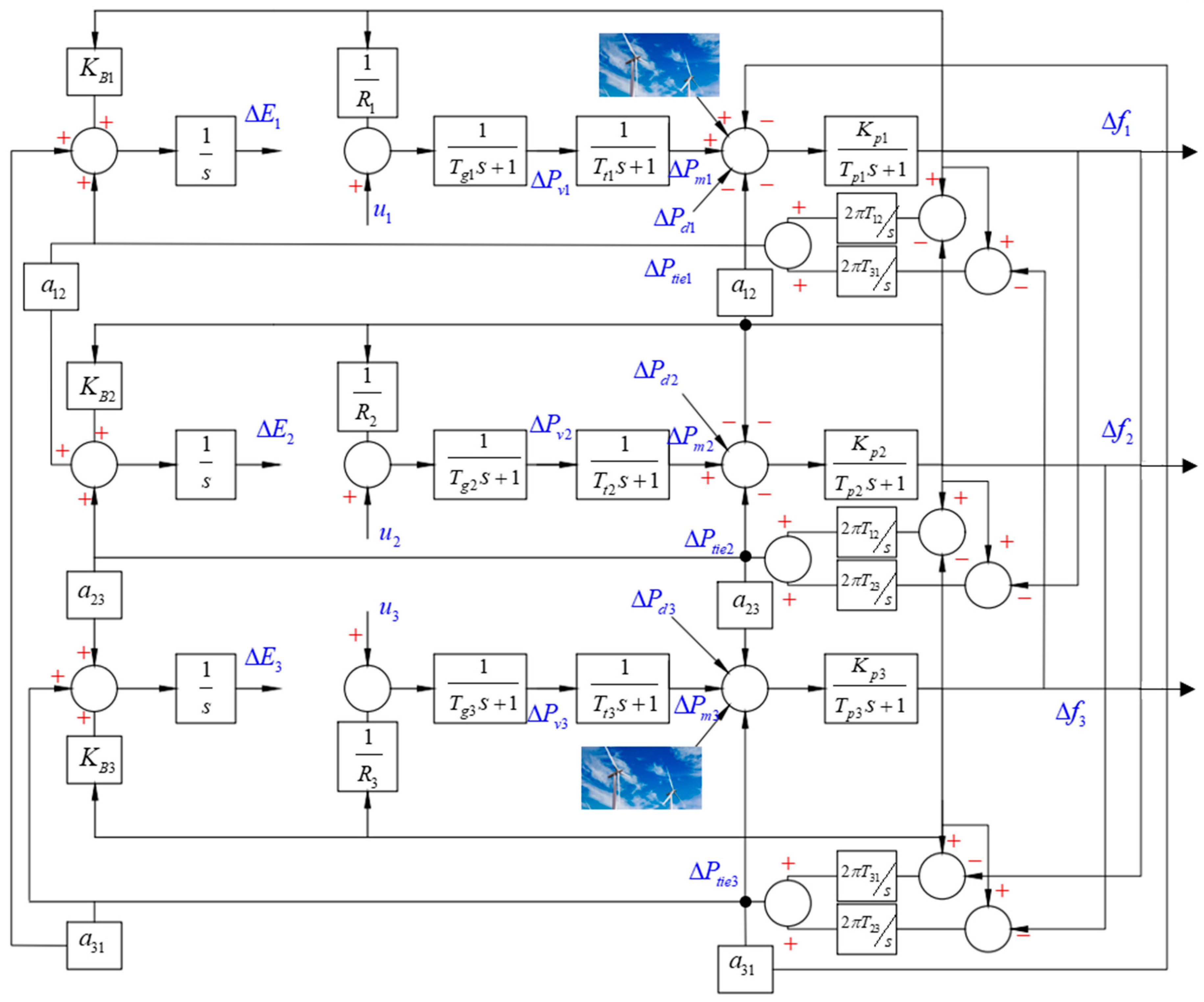




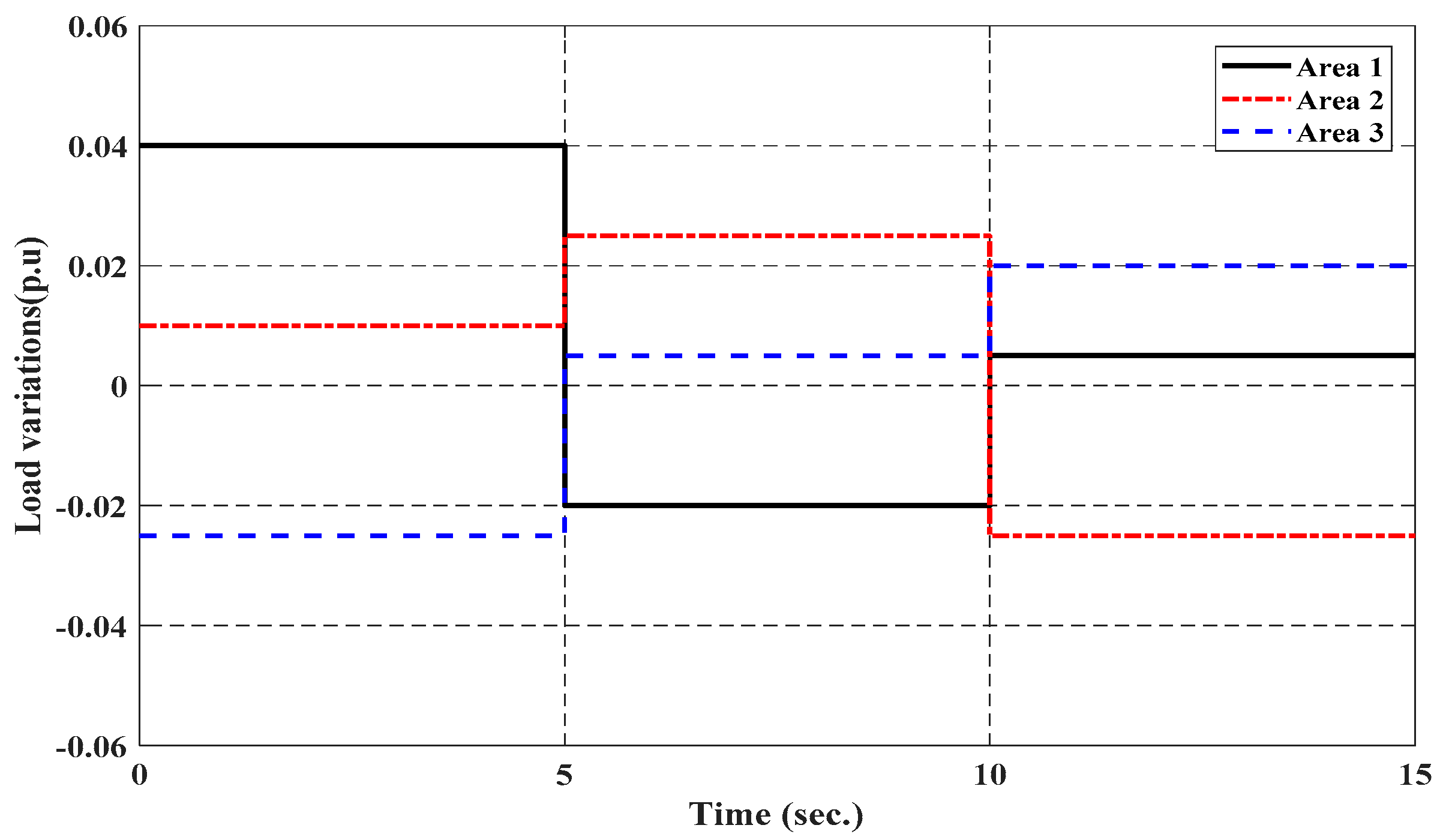


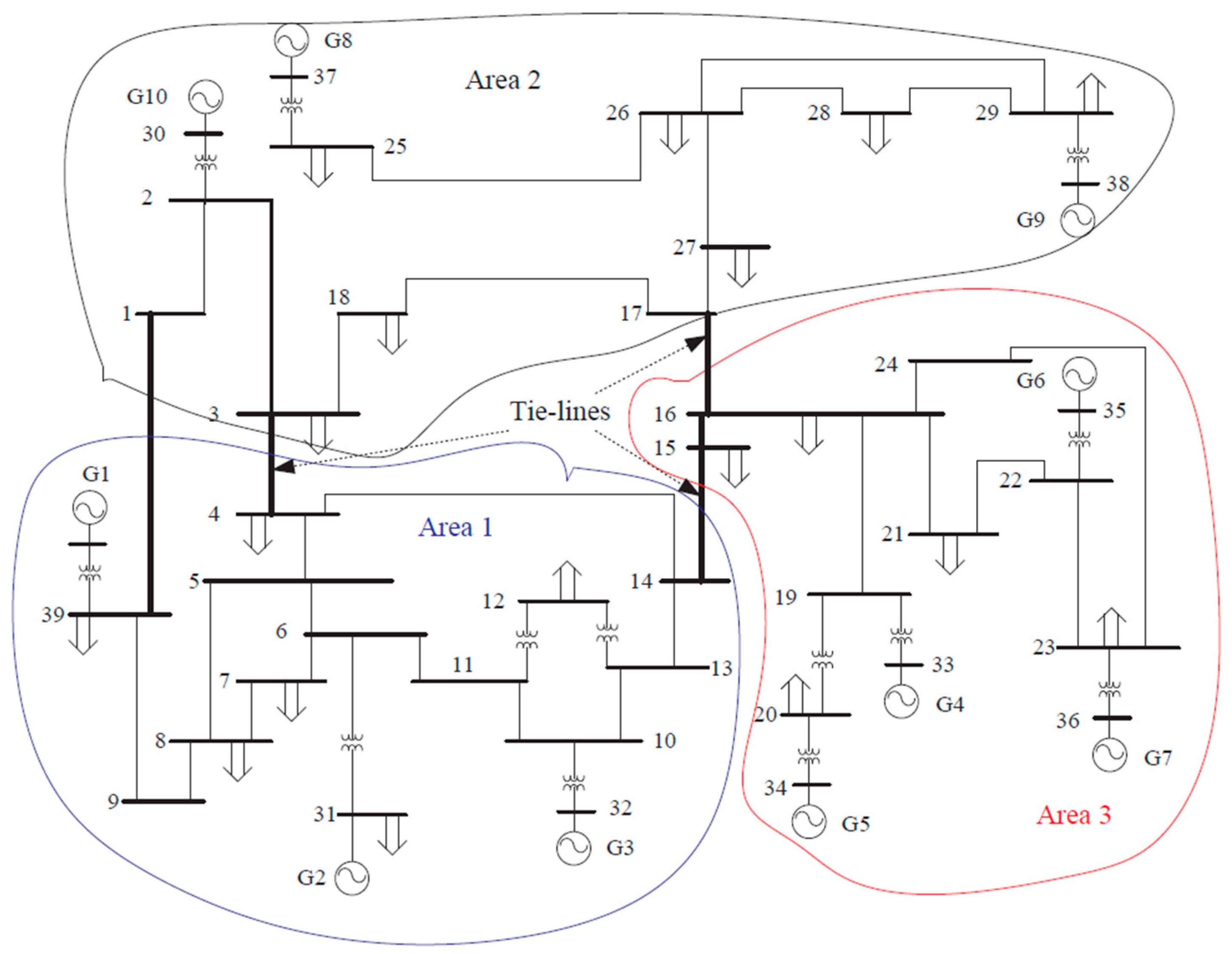
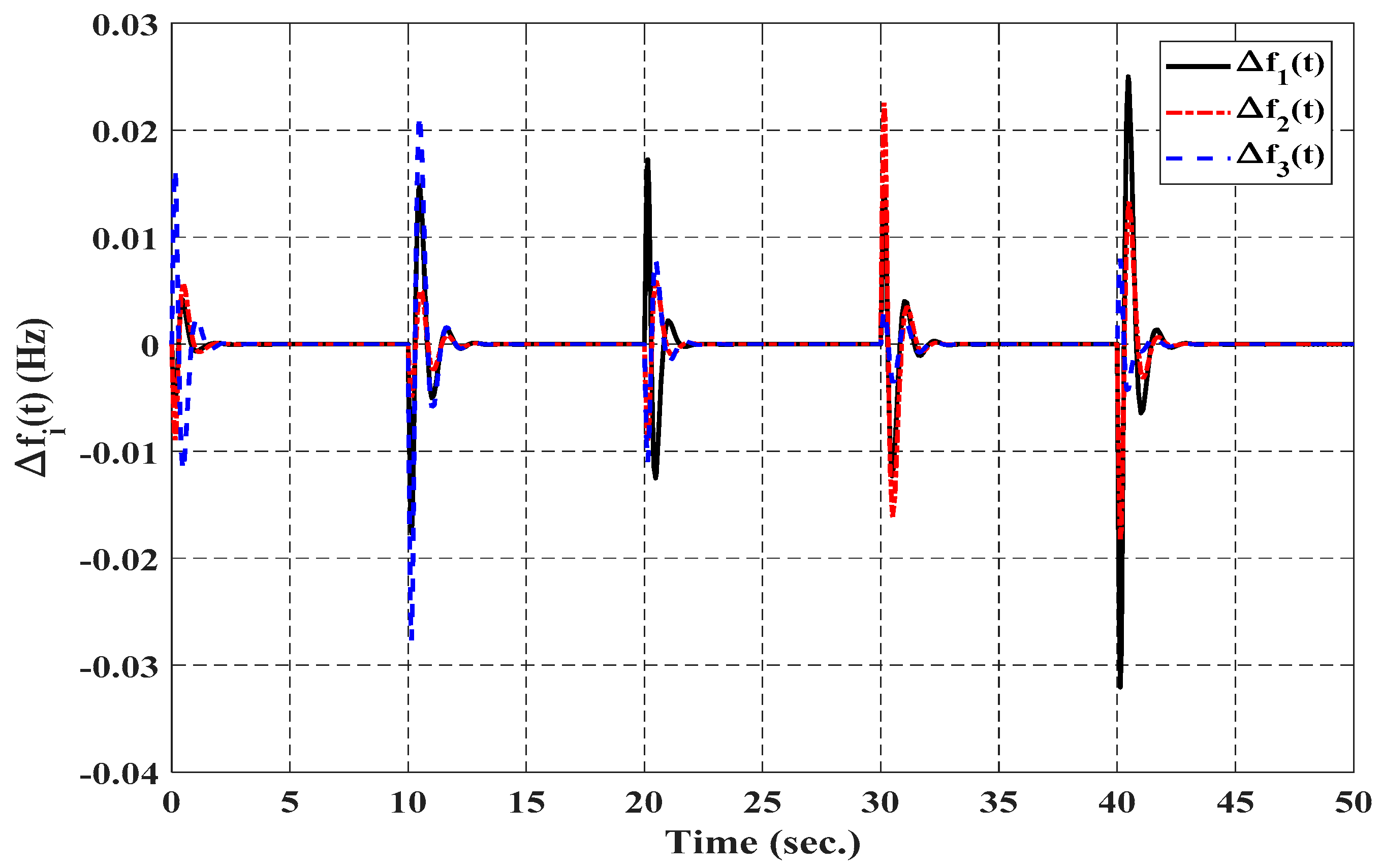
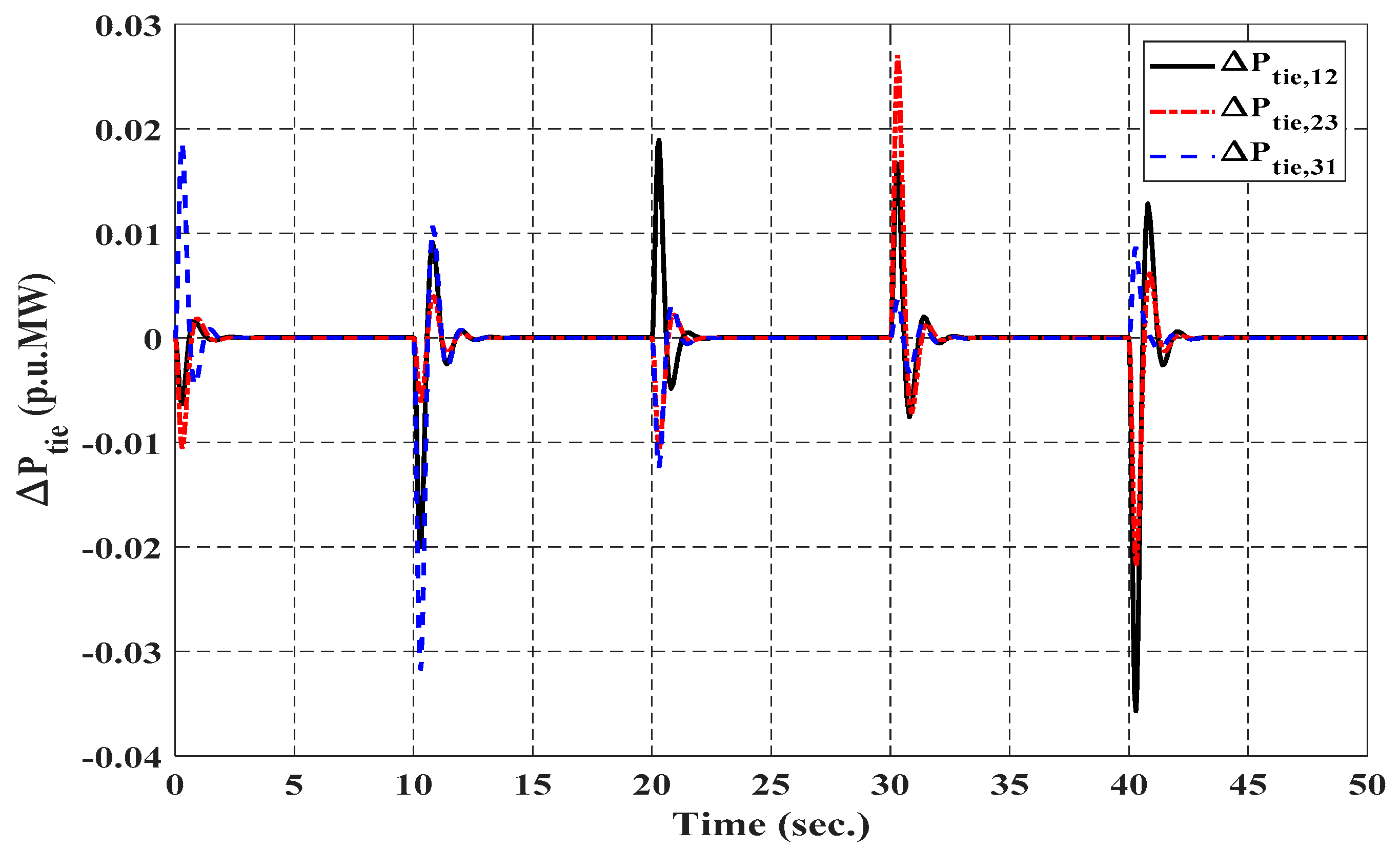
| Parameters | |||||
|---|---|---|---|---|---|
| Area 1 | 20 | 120 | 0.3 | 0.08 | 2.4 |
| Area 2 | 25 | 112.5 | 0.33 | 0.072 | 2.7 |
| Area 3 | 20 | 115 | 0.35 | 0.07 | 2.5 |
| Proposed HROSM via Single Phase Sliding Surface | The Approach Given in [31] | |||
|---|---|---|---|---|
| Frequency Errors | Settling Time [s] | Max.O. S [pu] | Settling Time [s] | Max.O. S [pu] |
| 1.5 | 0.003 | 2 | 0.005 | |
| 1.5 | 0.0019 | 2 | 0.003 | |
| 1.5 | 0.0019 | 2 | 0.003 | |
| Generations (bus No.) | M (Moment of Inertia of the Generator) | D (Generator’s Damping Rations) | (Governor Time Constant) | (Turbine-Generator Time Constant) | Linearization Parameter of the Governor Characteristic | ||
|---|---|---|---|---|---|---|---|
| r | |||||||
| G1 (39) | 3.0 | 4.0 | 0.25 | 0.2 | 250 | 39.4 | 19 |
| G2 (31) | 2.5 | 4.0 | 0.25 | 0.2 | 250 | 39.4 | 19 |
| G3 (32) | 4.0 | 6.0 | 0.25 | 0.2 | 250 | 39.4 | 19 |
| G4 (33) | 2.0 | 3.5 | 0.25 | 0.2 | 250 | 39.4 | 19 |
| G5 (34) | 3.5 | 3.0 | 0.25 | 0.2 | 250 | 39.4 | 19 |
| G6 (35) | 3.0 | 7.5 | 0.25 | 0.2 | 250 | 39.4 | 19 |
| G7 (36) | 2.5 | 4.0 | 0.25 | 0.2 | 250 | 39.4 | 19 |
| G8 (37) | 2.0 | 6.5 | 0.25 | 0.2 | 250 | 39.4 | 19 |
| G9 (38) | 6.0 | 5.0 | 0.25 | 0.2 | 250 | 39.4 | 19 |
| G10 (30) | 4.0 | 5.0 | 0.25 | 0.2 | 250 | 39.4 | 19 |
Publisher’s Note: MDPI stays neutral with regard to jurisdictional claims in published maps and institutional affiliations. |
© 2021 by the authors. Licensee MDPI, Basel, Switzerland. This article is an open access article distributed under the terms and conditions of the Creative Commons Attribution (CC BY) license (http://creativecommons.org/licenses/by/4.0/).
Share and Cite
Huynh, V.V.; Minh, B.L.N.; Amaefule, E.N.; Tran, A.-T.; Tran, P.T. Highly Robust Observer Sliding Mode Based Frequency Control for Multi Area Power Systems with Renewable Power Plants. Electronics 2021, 10, 274. https://doi.org/10.3390/electronics10030274
Huynh VV, Minh BLN, Amaefule EN, Tran A-T, Tran PT. Highly Robust Observer Sliding Mode Based Frequency Control for Multi Area Power Systems with Renewable Power Plants. Electronics. 2021; 10(3):274. https://doi.org/10.3390/electronics10030274
Chicago/Turabian StyleHuynh, Van Van, Bui Le Ngoc Minh, Emmanuel Nduka Amaefule, Anh-Tuan Tran, and Phong Thanh Tran. 2021. "Highly Robust Observer Sliding Mode Based Frequency Control for Multi Area Power Systems with Renewable Power Plants" Electronics 10, no. 3: 274. https://doi.org/10.3390/electronics10030274






